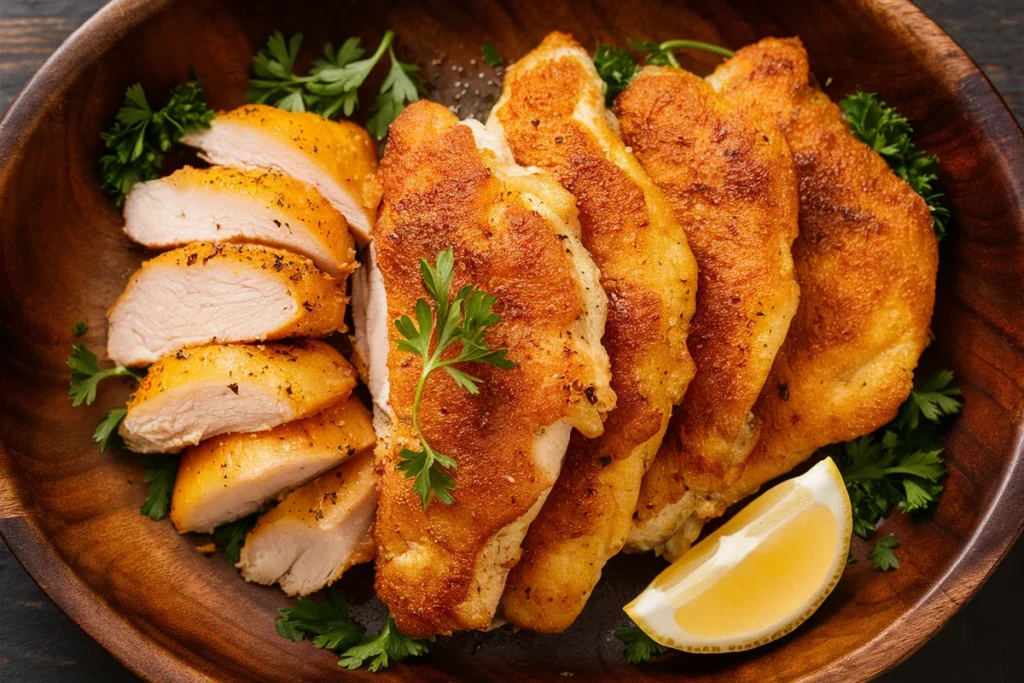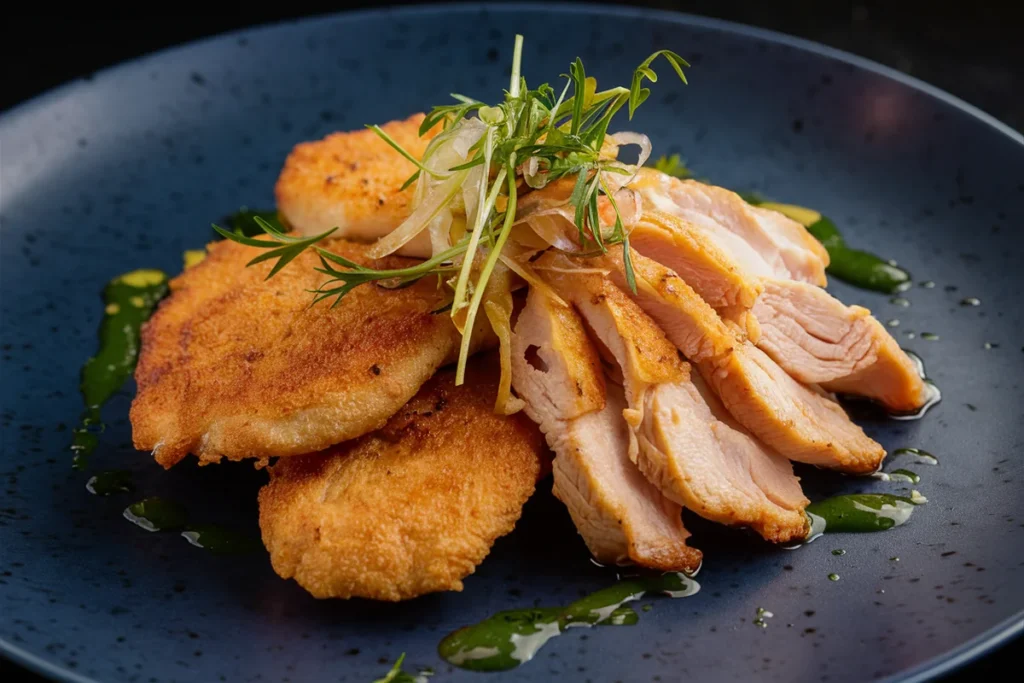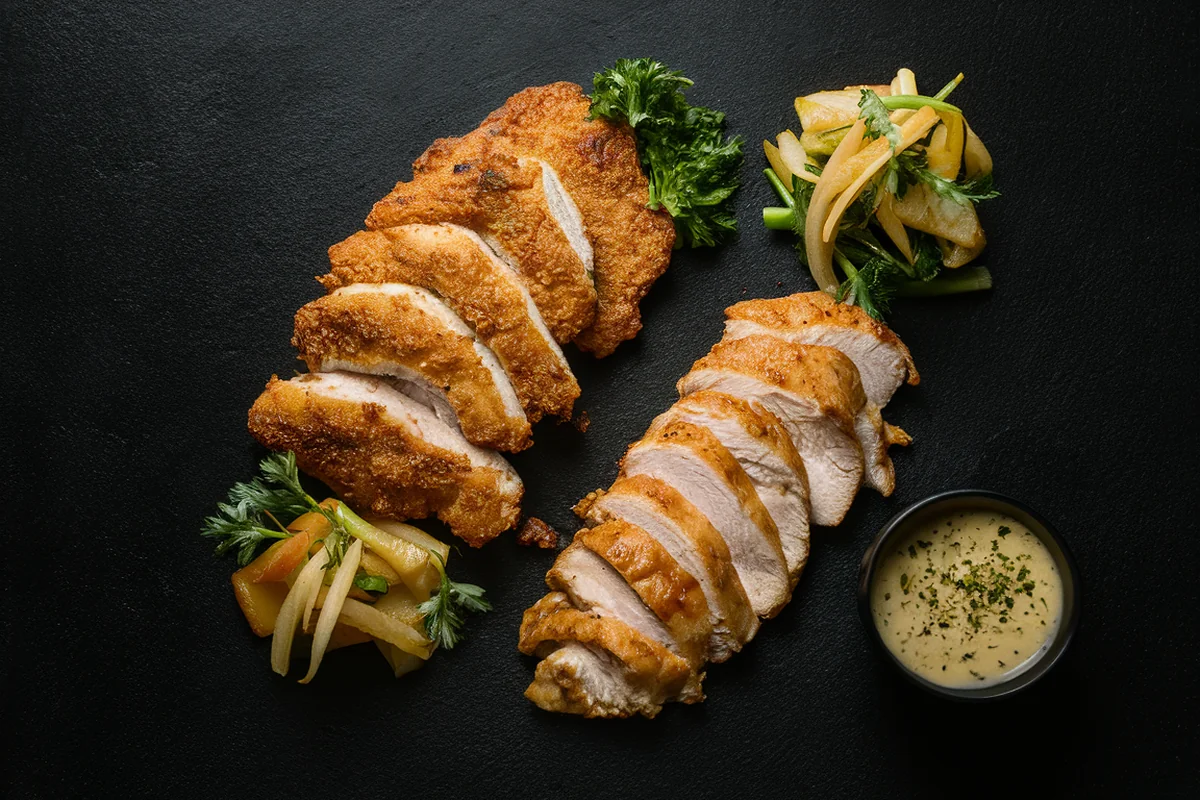Chicken is a staple in many households, celebrated for its versatility and nutritional benefits. However, when it comes to preparing chicken, the difference between chicken cutlets vs. thin-sliced chicken breast can be confusing, especially for those new to cooking or experimenting with different recipes. In this comprehensive guide, we’ll explore the distinctions between these two cuts, how they impact cooking methods, and when to use each for the best results.
What is a Chicken Cutlet? Understanding the Difference from Thin Sliced Chicken Breast
A chicken cutlet is a thin, boneless piece of chicken breast that has been either sliced from a whole breast or pounded to an even thickness. The pounding process breaks down the muscle fibers, making the meat more tender and quick to cook. This cut is especially popular in recipes that require fast cooking, ensuring the chicken remains juicy and tender.
How Chicken Cutlets Are Made
To create a chicken cutlet, a boneless, skinless chicken breast is typically sliced horizontally. If the resulting slice is not thin enough, it is then pounded with a meat mallet until it reaches the desired thickness, usually about ¼ inch. This process not only tenderizes the meat but also ensures it cooks evenly, which is crucial for certain dishes.
Common Uses for Chicken Cutlets
Chicken cutlets are incredibly versatile and are used in a variety of cuisines. Here are some popular uses:
- Italian Cuisine: Chicken cutlets are a key ingredient in dishes like Chicken Parmesan, where the cutlet is breaded, fried, and then baked with marinara sauce and cheese.
- Schnitzel: In German and Austrian cuisine, chicken cutlets are breaded and fried to create a crispy, golden exterior.
- Quick Sauté: Because they cook quickly, chicken cutlets are perfect for weeknight dinners where time is of the essence. They can be sautéed with garlic, herbs, and a splash of lemon juice for a quick and flavorful meal.
What is Thin Sliced Chicken Breast? How It Differs from Chicken Cutlets
Thin sliced chicken breast is exactly what it sounds like: a chicken breast that has been sliced horizontally into thinner pieces. Unlike cutlets, which are often pounded to achieve uniform thickness, thin sliced chicken breast is naturally thinner and may vary slightly in thickness depending on how it is cut. This cut is ideal for dishes that require a slightly thicker piece of chicken that still cooks relatively quickly.
How Thin Sliced Chicken Breast is Made
Thin slicing a chicken breast involves carefully cutting it horizontally. This can be done by starting at the thicker end and cutting through to the thinner end, creating two or more pieces. Unlike cutlets, these slices are not typically pounded, so they retain some of the natural variation in thickness that can add texture to certain dishes.
Common Uses for Thin Sliced Chicken Breast
Thin sliced chicken breast is a favorite for many cooks because it offers the best of both worlds: it’s thin enough to cook quickly but thick enough to retain some moisture and texture. Here are some common applications:
- Grilled Chicken Sandwiches: Thin slices are ideal for grilling because they cook evenly and fit well in a sandwich bun.
- Pan-Fried Dishes: When pan-fried, thin sliced chicken breasts develop a nice crust while staying juicy on the inside.
- Baking: These slices can be baked with a variety of seasonings or sauces, offering a healthier alternative to frying.
Physical Differences Between Chicken Cutlets and Thin Sliced Chicken Breast
Understanding the physical differences between chicken cutlets and thin sliced chicken breast is key to using them correctly in your cooking.

Thickness and Shape
- Chicken Cutlets: These are generally pounded flat, resulting in a uniform thickness that is ideal for quick cooking methods. The shape is often more consistent, which can be important in recipes that require even cooking.
- Thin Sliced Chicken Breast: These slices are thinner than a whole breast but thicker than a cutlet. The thickness can vary depending on how the breast is sliced, leading to slight differences in cooking time across a single piece.
Visual Differences
- Appearance: Cutlets are uniform in thickness and have a smooth surface due to the pounding process. Thin sliced chicken breasts retain more of their natural shape, with some variation in thickness.
- Size: While cutlets are usually smaller and more uniform in size, thin sliced chicken breasts may retain more of the original breast’s size and shape, just in a thinner form.
Cooking Techniques for Chicken Cutlets vs Thin Sliced Chicken Breast
The way you cook chicken can greatly affect the final dish. The thickness and shape of the cut will determine the best cooking method, the ideal cooking time, and the final texture of the chicken.
Cooking Chicken Cutlets
Because chicken cutlets are thin and evenly pounded, they cook very quickly, making them ideal for fast cooking methods:
- Sautéing: This is one of the most common methods for cooking chicken cutlets. Heat a pan with a small amount of oil or butter, and cook the cutlets for about 2-3 minutes on each side until they are golden brown and cooked through.
- Pan-Frying: Breaded cutlets can be pan-fried in shallow oil to create a crispy exterior while keeping the inside juicy. This method is often used in recipes like Chicken Milanese or Chicken Parmesan.
- Grilling: Though less common, cutlets can be grilled, especially when marinated. Their thinness allows them to cook quickly, but care must be taken to avoid overcooking, which can lead to dryness.
Cooking Thin Sliced Chicken Breast
Thin sliced chicken breast offers more versatility in cooking due to its slightly thicker nature:
- Grilling: Thin slices are perfect for grilling because they cook evenly and develop nice grill marks. Marinating beforehand can enhance flavor and prevent the chicken from drying out.
- Pan-Seared: A quick sear in a hot pan can lock in juices while creating a flavorful crust. This method is great for adding to salads or serving with a sauce.
- Baking: Thin sliced chicken breasts can be baked with a variety of herbs, spices, and sauces. Because they are slightly thicker than cutlets, they retain more moisture when baked, making them ideal for dishes like baked chicken with vegetables or a simple sheet pan dinner.
For those interested in perfecting their slicing technique, you can learn how to slice chicken breast to ensure even cooking and the best results.
Taste and Texture: Comparing Chicken Cutlets and Thin Sliced Chicken Breast
The difference in thickness between chicken cutlets and thin sliced chicken breast leads to noticeable differences in taste and texture.
Flavor Absorption
- Chicken Cutlets: The thinness of cutlets allows them to absorb marinades and seasonings more quickly. This makes them ideal for dishes where you want the chicken to take on the flavor of the marinade or sauce.
- Thin Sliced Chicken Breast: While thin sliced breasts also absorb flavors well, their slightly thicker nature means they may need a bit more time in marinades to achieve the same depth of flavor as cutlets.
Texture Differences
- Chicken Cutlets: Because they are pounded thin, cutlets have a tender, almost delicate texture. This makes them particularly suited for dishes where the chicken needs to be soft and moist.
- Thin Sliced Chicken Breast: These slices retain more of the breast’s natural texture, offering a balance between tenderness and a satisfying bite. They are less likely to dry out compared to whole breasts, but they still provide a more substantial mouthfeel than cutlets.
Nutritional Differences Between Chicken Cutlets and Thin Sliced Chicken Breast
While both cuts come from the same part of the chicken, their nutritional profiles can differ slightly depending on how they are prepared and cooked.
Caloric Content
- Chicken Cutlets: The caloric content of chicken cutlets is primarily influenced by how they are cooked. For example, breaded and fried cutlets will have more calories due to the added breading and oil. In contrast, a sautéed or grilled cutlet without additional fats will have fewer calories.
- Thin Sliced Chicken Breast: These slices are typically lower in calories, especially when grilled or baked without added fats. They offer a lean protein source that is ideal for those looking to manage their calorie intake.
Nutrient Variation
- Fat Content: Cutlets may have a higher fat content if cooked with added oils or breaded and fried. However, when prepared with minimal fat, they remain a lean source of protein.
- Protein Content: Both cuts are high in protein, making them excellent choices for muscle repair and overall health. The method of preparation has a minimal impact on the protein content.
- Vitamins and Minerals: Both cuts are rich in essential vitamins and minerals, such as B vitamins, selenium, and phosphorus, which are important for energy production, immune function, and bone health.
Practical Considerations
When deciding whether to use chicken cutlets or thin sliced chicken breast, consider the specific needs of your recipe, your budget, and your cooking skills.

When to Use Chicken Cutlets vs. Thin Sliced Chicken Breast
Choosing between these two cuts often depends on the dish you’re preparing and the cooking time available:
- Chicken Cutlets: Use cutlets when you need a quick-cooking, tender cut for frying or sautéing. They are ideal for recipes that require uniform thickness, such as Chicken Parmesan or Chicken Piccata.
- Thin Sliced Chicken Breast: Opt for thin sliced chicken breast when grilling or when you need a slightly thicker cut for baking or stir-frying. These slices are versatile and can be used in a wide range of dishes, from sandwiches to stir-fries.
Cost and Availability
- Price Comparison: Chicken cutlets are often more expensive than thin sliced chicken breast due to the additional processing required to pound them thin. However, this can vary depending on where you shop and whether you buy pre-cut cutlets or make your own.
- Availability: Thin sliced chicken breast is generally more readily available and less costly. You can often find pre-packaged thin slices in the meat section of most supermarkets, while cutlets may require a visit to a butcher or specialty store.
Storage and Shelf Life
Proper storage is essential to maintaining the quality of your chicken, regardless of the cut:
- Refrigeration: Both cuts should be kept in the refrigerator and used within 1-2 days of purchase to ensure freshness. If you don’t plan to use them immediately, freezing is a good option.
- Freezing: To freeze, place the chicken in an airtight container or vacuum-sealed bag. Both cuts can be stored in the freezer for up to 6 months. When ready to use, thaw in the refrigerator overnight for best results.
- Shelf Life: Frozen chicken cutlets and thin sliced chicken breasts have a similar shelf life when stored properly. However, because cutlets are thinner, they may thaw more quickly than thin slices, which is something to keep in mind when planning your meals.
Frequently Asked Questions
Can you substitute chicken cutlets for thin sliced chicken breast in recipes?
Yes, you can substitute one for the other in most recipes. However, be aware that the cooking times may vary. Chicken cutlets cook faster due to their thin, uniform thickness, so you may need to reduce the cooking time to avoid overcooking. On the other hand, thin sliced chicken breast may require slightly longer cooking, depending on its thickness.
Is one healthier than the other?
Both cuts are lean and nutritious, making them excellent choices for a healthy diet. The healthiness of either cut depends more on the cooking method than the cut itself. For example, grilled or baked thin sliced chicken breast is a healthier option than breaded and fried chicken cutlets. If you’re looking to reduce calories and fat, opt for cooking methods like grilling, baking, or sautéing with minimal oil.
Do they cook at the same rate?
Not exactly. Chicken cutlets typically cook faster because they are thinner and more uniform in thickness. Thin sliced chicken breast can vary in thickness, which may lead to slightly longer cooking times. Always check for doneness using a meat thermometer to ensure the chicken reaches an internal temperature of 165°F (74°C).
Can you make your own cutlets or thin slices at home?
Absolutely! Making your own chicken cutlets or thin sliced chicken breast is simple and cost-effective. For cutlets, start with a boneless, skinless chicken breast and slice it horizontally. Then, place the slices between two sheets of plastic wrap and gently pound them to an even thickness with a meat mallet. To create thin slices, carefully slice a chicken breast horizontally without pounding. This technique allows you to control the thickness and ensures your chicken cooks evenly.
Conclusion
Understanding the differences between chicken cutlets and thin sliced chicken breast can significantly improve your cooking results. Both cuts offer unique benefits, and knowing when to use each can make your meals more delicious and satisfying.
- Chicken cutlets are best for quick-cooking recipes that require a tender, even thickness, making them ideal for dishes like Chicken Parmesan and Schnitzel.
- Thin sliced chicken breast offers more versatility, working well in grilled, pan-seared, or baked dishes where a bit more thickness and texture is desirable.
By mastering these cuts, you’ll have the flexibility to create a wide range of delicious dishes, whether you’re cooking a quick weeknight dinner or preparing a special meal for guests. Remember, the key to a great dish lies not just in the ingredients but also in the preparation. Choose wisely, cook with care, and enjoy the flavorful results!
